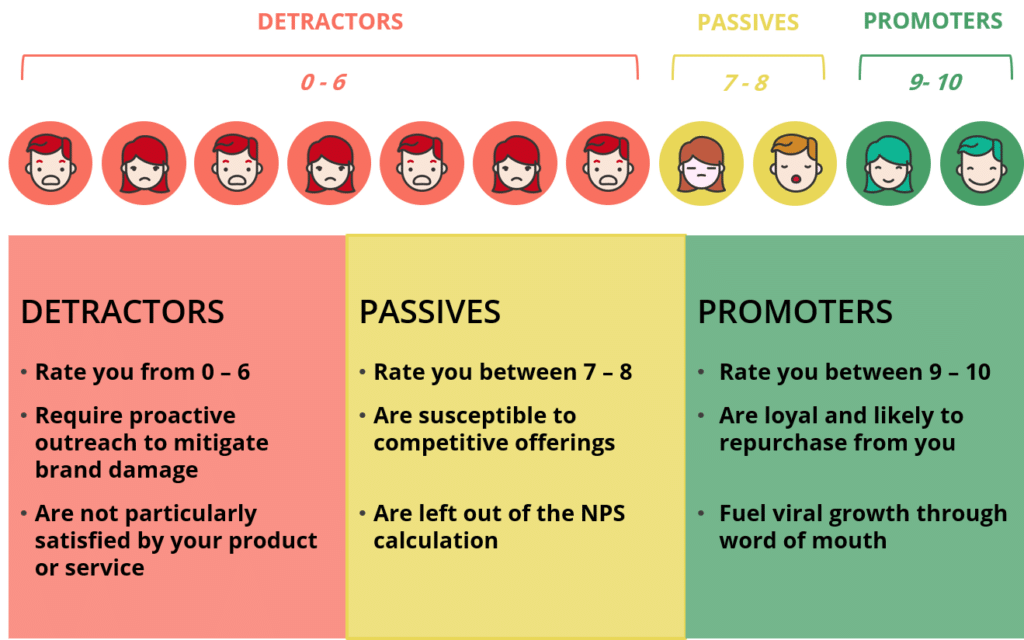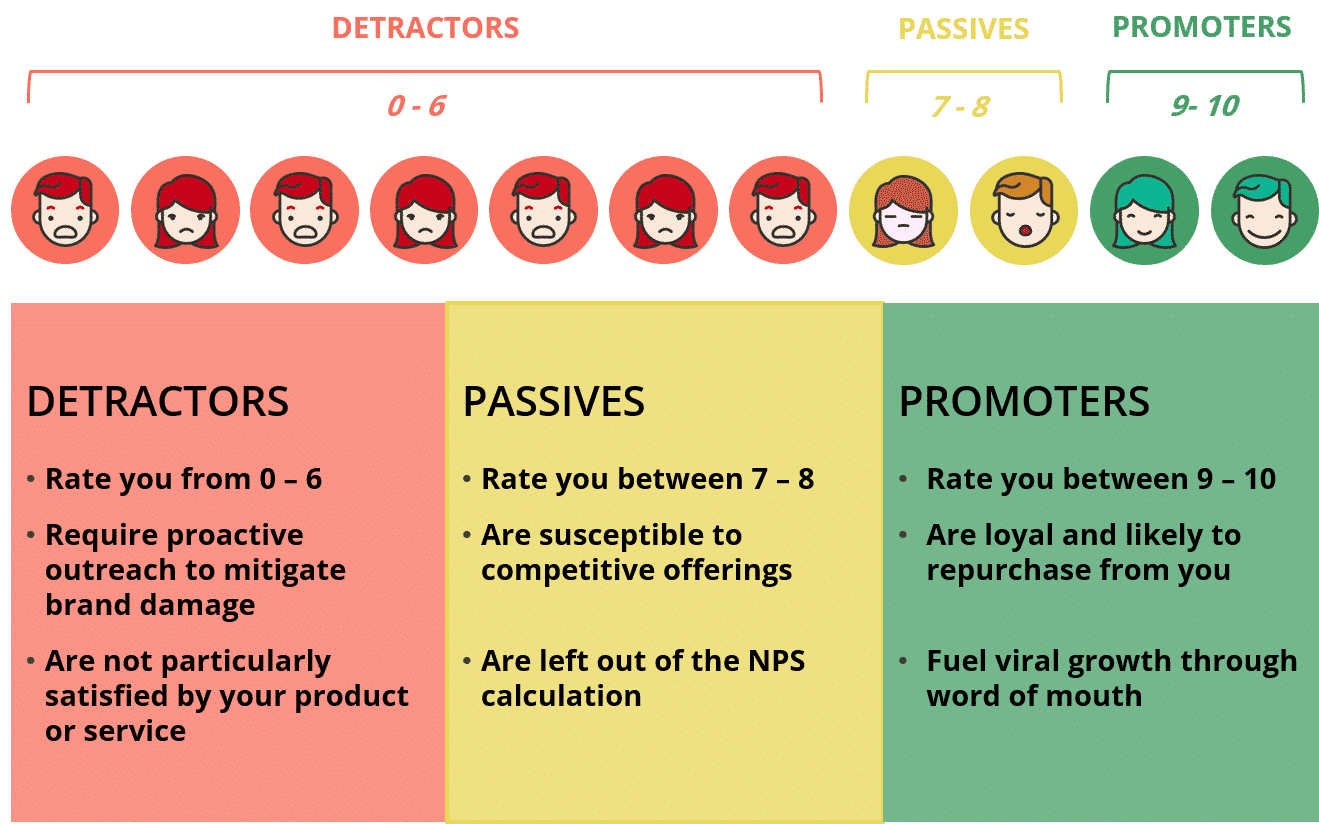The one and only question to be asked to learn about your customer satisfaction NPS is:
“On a scale of 0 to 10 (10 being most likely), how likely are you to recommend us to your friends/colleagues?”
This question was originally formed by Fred Reichheld and Bain & Company, and makes an appearance in most surveys today. Businesses of all shapes, sizes, scope, and industries are conducting online customer experience surveys to better understand how customers feel about their experiences with a particular brand. In a day and age when the overall success and growth of a business rests upon customer experience and sentiment, customer satisfaction surveys have become gold.
Reichheld published an article in Harvard Business Review in 2003 explaining that the ONE number businesses need to grow isn’t their gross profit, their annual sales goal, nor is it their bottom line; it’s their NPS score.
What is NPS?
NPS stands for Net Promoter Score®
, which has become an incredibly valuable way to measure customer satisfaction levels and to predict business growth. In fact, this proven metric has become the core standard of measurement for customer improvement and retention programs. As well as customer experience management (CEM) programs for businesses all over the world.
How do you measure NPS?
How exactly do you measure and calculate NPS? As we mentioned briefly above, NPS collects data from a standard numerical system and scale: 0 to 10, with 10 being the most likely a customer would recommend a brand to someone they know, and 0 being the least likely.
When survey participants respond to the question, their answers are grouped accordingly in the following categories:
- Promoters (score 9-10) – These people are loyal enthusiasts of your brand. They are highly likely to make a future purchase, and refer your brand to others. These customers are also fuel to propelling business growth.
- Passives (score 7-8) – These people are satisfied with their overall experience with your brand, but are less enthusiastic than Promoters. These are also the customers who are most likely to be tempted by other competitive offers.
- Detractors (score 0-6) – These are unhappy customers who have had an unpleasant experience with your brand. They will likely “bad-mouth” your brand to others, which can damage your brand and hinder future business growth.
How is NPS calculated?
by subtracting the per cent of Detractors from the per cent of Promoters. A positive NPS (over 0) is a good score, whereas a score over 50 is considered excellent.
For example, let’s say your NPS results are 20 per cent Detractors and 50 per cent Promoters. Simply subtract 20 per cent from 50 per cent, which equals 30 per cent. Therefore, your NPS is 30. Not bad!

How do you analyse the results?
Using your NPS as your core metric for measuring customer experience and satisfaction is powerful enough to completely transform your business. NPS has become a reliable, dependable, and valuable anchor for customer experience management (CEM), customer retention, and customer improvement programs.
One of the disadvantages of NPS is that it doesn’t provide deep data. Therefore, businesses may need to consider adding other survey methods, asking additional questions or using other metrics and insights to collect clear, actionable data. It’s also a good idea to collect data and insights from various points along the customer journey to provide a clear, “big picture”, comprehensive, and actionable view of the overall customer experience and your brand’s performance.
How to increase customer satisfaction
It is easy for companies to miss the NPS mark. Regardless of whether a brand receives a positive or negative NPS score. Here are some ways to increase customer satisfaction and experiences.
Take Action.
Companies can collect and analyse customer satisfaction data all day, but if they don’t take the necessary steps to act on implementing improvement systems, then the data is useless. It’s important for businesses to remember that the key to success is not necessarily the metric you use to collect, measure, and analyse data; it’s the action that makes the biggest difference. The goal is simple: Increase the number of Promoters and decrease the number of Detractors.
Pay Attention.
Although every customer category is crucial, Promoters and Detractors require special attention. Yes, the data is important, but perhaps what is most important is why an individual selected a particular score. What do customers love most? What do they dislike most? Is it customer service? Quality? Affordability? Accessibility? These are all important questions to consider when analysing results and taking the next course of action.
Start Conversations.
NPS should be a starting point. Once a company receives its NPS score, the next step should be to have open discussions with customers about why they selected their particular scores. This opens up the opportunity to engage with customers directly to improve their experiences or to reach another solution.
Remember, the whole of NPS is to help companies establish and build upon relationships, not necessarily increase transactions. With that being said, NPS is designed to measure the customer experience as a whole rather than an individual transaction.
Ask the Right Questions at the Right Time.
The most challenging part of NPS is asking the RIGHT questions at the RIGHT time. The driving point behind NPS is to ask an individual to rate his or her overall experience with a brand as a whole, not an individual employee. If you want customers to rate their experience with a particular employee, then save that for a different question.
One company’s NPS success
, one of the largest media companies in Norway reached out to Netigate to measure its customer’s satisfaction levels, particularly surrounding its media content. Egmont’s project was set up with the following KPIs: monthly NPS and satisfaction levels surrounding the magazine’s content, front page, and delivery. The survey took under two minutes to complete and collected over 2200 responses. Which translated to a 14.4 per cent average response rate.
After analysing and comparing results from the survey and statistics from Egmont’s customer base, there was a direct link between NPS and customer termination. Metrics showed that 60 per cent of those with low scores in Q1 were no longer customers by Q3. These insights gave Egmont a clear indication of whom to contact to avoid customer exit.
Moving forward: find out what they really think…
In summary, NPS is a customer satisfaction and customer experience tool that has helped countless businesses grow. In addition to providing invaluable results and insights, the NPS also takes two minutes to complete, and only asks one or two questions. “How would you rate your experience?” and “Why?” These are the most common questions to ask, and the questions that provide the most crucial feedback for any company.
One of the best ways to implement NPS in your own company is to adopt a system that accurately collects and analyses key customer data. Netigate is the world’s top-rated insight platform and is available to help companies collect and analyse data as well as improve customer satisfaction results.








 Copyright © 2024 Netigate AB, Drottninggatan 25, 111 51, Stockholm, Sverige
Copyright © 2024 Netigate AB, Drottninggatan 25, 111 51, Stockholm, Sverige 